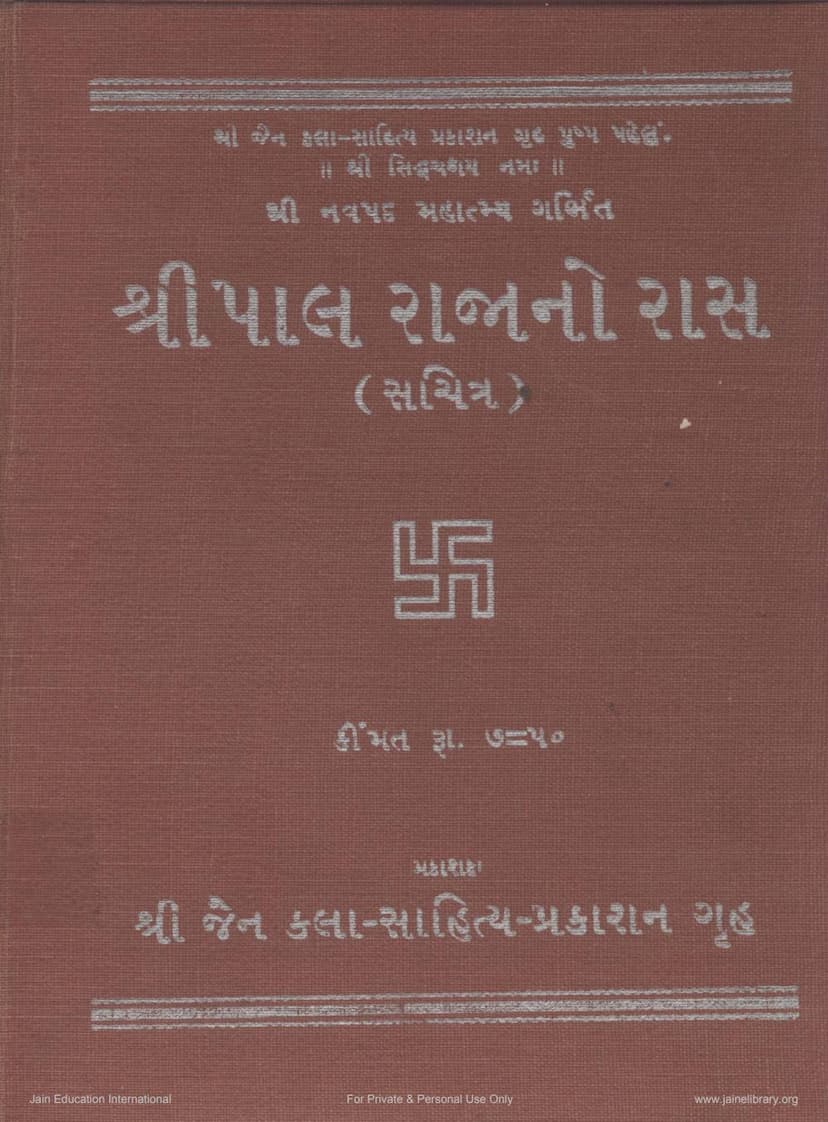Shripal Raja No Ras
Added to library: September 2, 2025

Summary
Here's a comprehensive summary of the Jain text "Shripal Raja no Ras" by Sarabhai Manilal Nawab, based on the provided content:
Book Title: Shripal Raja no Ras (The Ballad of King Shripal) Author: SarabhFor Manilal Nawab Publisher: Jain Kala Sahitya Prakashan Gruh Publication Year: Samvat 2016 (1960 CE)
This work, "Shripal Raja no Ras," is a significant publication by Shri Jain Kala Sahitya Prakashan Gruh, serving as its inaugural release. The text focuses on the renowned Jain narrative of King Shripal, a story deeply embedded in Jain tradition, celebrated for its connection to the veneration of Navpad (the Nine Sacred Entities) and Siddha Chakra (the Wheel of Siddhas).
Content Overview:
The book is presented as a collection of verses (Ras) detailing the life and spiritual journey of King Shripal. The text is structured into several chapters (Khand) and sections (Dhal), with the provided excerpt primarily covering the first chapter, introducing the premise and the initial stages of Shripal's life and the context of his story.
Key Themes and Narrative Elements:
-
The Significance of Navpad and Siddha Chakra: The core of the narrative revolves around the worship and veneration of the Nine Sacred Entities (Navpad) and the Siddha Chakra. The text emphasizes the transformative power of this worship, suggesting it leads to immense happiness, prosperity, and ultimately, liberation (Moksha). King Shripal's life is presented as a testament to the efficacy of this devotion.
-
King Shripal's Life Story:
- Origin and Setting: The narrative begins by setting the scene in Malwa, highlighting its prosperity and the city of Ujjain as a jewel within it, surpassing even celestial cities in its grandeur. The king of Ujjain during this time is named Prajpāl, and he has two queens: Saubhagyasundari and Rupasundari. While Saubhagyasundari follows a false path (Mithyatva), Rupasundari is virtuous and devoted to Samyaktva (right faith).
- Royal Daughters: Both queens bear daughters. Saurasundari's daughter is named Sursundari, and Rupasundari's daughter is named Mayanasundari. Both princesses receive excellent education, with Mayanasundari notably being taught Jain principles and philosophy.
- Sursundari's Marriage: A significant event is the marriage of Sursundari to Aridamana, the prince of Shankhapur, a decision influenced by her attraction to him. This event is depicted as the king fulfilling his daughter's desires.
- Mayanasundari's Virtue and Challenges: Mayanasundari, adhering to Jain principles, faces adversity. Her father, Prajpāl, driven by anger and pride after her seemingly defiant statements, arranges her marriage to a leper king (Umber Rano). Despite the dire circumstances, she remains steadfast in her faith and conduct.
- The Role of Miracles and Divine Intervention: The text hints at the miraculous. The leper king, through the blessings of the Siddha Chakra and the devotion of Mayanasundari, is eventually cured. This miraculous cure underscores the power of Jain practices.
- The Shripal's Journey: The narrative then shifts to the story of King Shripal himself, detailing his lineage, his mother Kamalādevi's devotion to Siddha Chakra, and his eventual ascension to the throne after overcoming numerous challenges, including the curse of the leper king and the subsequent divine intervention that leads to his true auspiciousness and the restoration of his kingdom. The story emphasizes how King Shripal, through his unwavering faith and devotion to the Siddha Chakra, overcomes all obstacles and achieves great merit and prosperity.
- The Importance of a Guru: The text highlights the crucial role of a Guru (spiritual teacher) in guiding individuals, particularly in understanding and practicing the tenets of Jainism. The Guru's teachings and blessings are shown to be instrumental in overcoming adversity and achieving spiritual growth.
-
Literary Style and Structure:
- Poetic Form: The "Ras" is written in a poetic, lyrical style, employing various meters and descriptions to make the narrative engaging. The use of "Dhal" (stanzas or verses) categorizes the progression of the story.
- Illustrations: The mention of "(Sachitra)" indicates that the book is illustrated, adding a visual dimension to the storytelling, which was common in historical religious texts.
- Comprehensive Content: The "Vishayanukram" (Table of Contents) reveals the broad scope of the book, covering not just Shripal's life but also detailed descriptions of Siddha Chakra worship, Navpad names, their significance, and various rituals associated with them.
Author and Publisher:
Sarabhai Manilal Nawab, as the editor and researcher, brings a scholarly approach to this compilation. The Jain Kala Sahitya Prakashan Gruh, through this publication, aims to promote Jain art and literature, making these important religious texts accessible to the public.
Overall Message:
"Shripal Raja no Ras" serves as a didactic text, illustrating the principles of Jainism through a compelling historical narrative. It reinforces the importance of faith, devotion, righteous conduct (charitra), and the observance of rituals like the worship of the Siddha Chakra and Navpad as a path to spiritual and worldly well-being. The story of King Shripal's life, marked by trials and eventual triumphs through divine grace and devotion, offers a powerful message of hope and spiritual guidance to the readers.